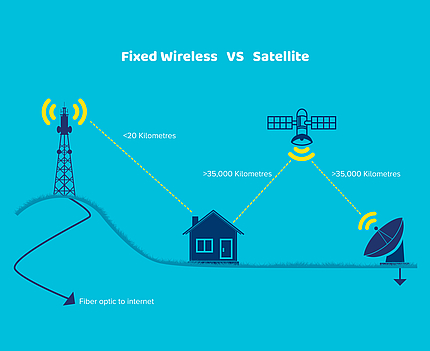Blog
Rural Internet Connectivity Guide

Rural living has many advantages, like wide-open spaces, clean air, and less traffic. But one area that can be frustrating is finding high-quality internet service.
Internet access depends on many layers of infrastructure built to handle an ever-increasing demand from customers. In larger towns and cities, internet is typically delivered through a wired infrastructure, such as optical fibre, hybrid fibre-coaxial or DSL. In rural areas, relying solely on this infrastructure may not be possible, so internet providers use a variety of different technologies to bring customers the speeds they want, including satellite, cellular, and fixed-wireless.
At Access, we make rural connectivity a priority - we've built a network of 119 fixed-wireless towers to bring internet access to over 20,000 homes and businesses across the province. Here’s a guide to help you learn about this technology and how it compares to other technologies available.
What is fixed-wireless internet?
Fixed-wireless internet is a relatively new form to connect rural and hard to reach areas. Fixed-wireless internet means internet that is delivered between two fixed (stationary) locations, such as a tower and a building, via radio signals instead of a traditional cable.
It is simple: you mount a small radio or antenna on your home or nearby mast, which points to the tower with the best line of sight. Towers (also called base stations) are connected to the fibre optics network infrastructure and bring you the internet by transmitting wireless signals to the equipment at your home. Secondary or repeater towers provide additional reach by multiplying the signal in remote areas.
What are the benefits of fixed-wireless internet?
We chose this technology because of its overall reliability, speeds and benefit to rural customers. Fixed-wireless has the advantage of low latency (the time it takes for data to travel) because the signal has a shorter distance to travel. The tower is usually located less than 20km away from your property, making it ideal for streaming, video calling and online gaming. We can offer download speeds of 25 Mbps in most locations and there are no limits to how much you can use the internet.
How does fixed-wireless compare to satellite internet?
Satellite internet is like satellite TV: you mount a dish on your home to communicate with a satellite in space. Your internet provider sends a signal to the satellite in space which then relays it to you. In addition to the dish, you also need a modem and cables running from the dish to your modem.

Both options offer ample coverage in rural areas where wired internet options would not be available. Satellite internet is more widely available and sometimes may be the only option available in more remote areas. Fixed-wireless internet is not available in as many areas with low population density because it requires line of sight connectivity to a tower.
Minor weather events do not usually affect either of the services, but snow, rain, or wind storms are known to block satellite signals, causing poor or total loss of internet services, making fixed-wireless a more reliable choice.
Another difference is in terms of latency (the time it takes for data to travel). Satellite internet has poor latency because the signal has a much longer distance to travel (thousands of kms away in space), whereas with fixed-wireless internet the signal has a much shorter distance to travel (the tower is usually located less than 20 km away from your property). This makes fixed-wireless internet ideal for streaming, video calls and online gaming.
Finally, satellite providers often impose limits to data usage, meaning that you will have so much bandwidth to use before your provider throttles your connection (slows it down) or you are charged for data overage. Access does not impose such limits to customers.
What is line of sight?
Line of sight is the unobstructed path between the antenna (or radio) and a nearby tower.
What is the difference between Wi-Fi, wireless and fixed-wireless?
These terms can be confusing and interchangeable when talking about internet access. Wi-Fi is a technology allowing devices to connect to the internet or with one another without the need of cables or wires.
Although many people equate Wi-Fi with internet, they are not the same. In fact, internet service must be in place before Wi-Fi for your Wi-Fi connection to work. If you have a Wi-Fi router in your home, it is connected directly to your internet source (likely a cable in a wall), and then wirelessly transmits signals to your devices.
Fixed-wireless internet means internet that is delivered between two fixed (stationary) locations via radio signals instead of a traditional cable. This makes it excellent for rural connectivity because it can be installed virtually anywhere there is a tower available! Wireless does not mean cellular: fixed-wireless internet uses separate towers to bring the internet to you and the network is optimized for usage at home.
What kind of performance should I expect from fixed-wireless internet?
Use your fixed wireless internet for browsing, streaming and gaming just as you would with cable internet. Our plans can be as fast as 25 Mbps downloads in most areas.
How do I sign up for rural internet?
Check our service coverage map to find out if this service may be available in your area. Access provides multiple internet packages to fit every budget and household use. Then, give us a call or fill out our site survey request form to book your site survey. During the site survey, our technicians will work with you to determine the best speeds available at your location and explain the set up.
What can I do if my area is not covered?
If we do not offer coverage in your area, reach out to us. Our network consists of 119 towers across Saskatchewan and we are constantly expanding based on customer demand. Depending on your needs, our team can work on a custom solution with you.


